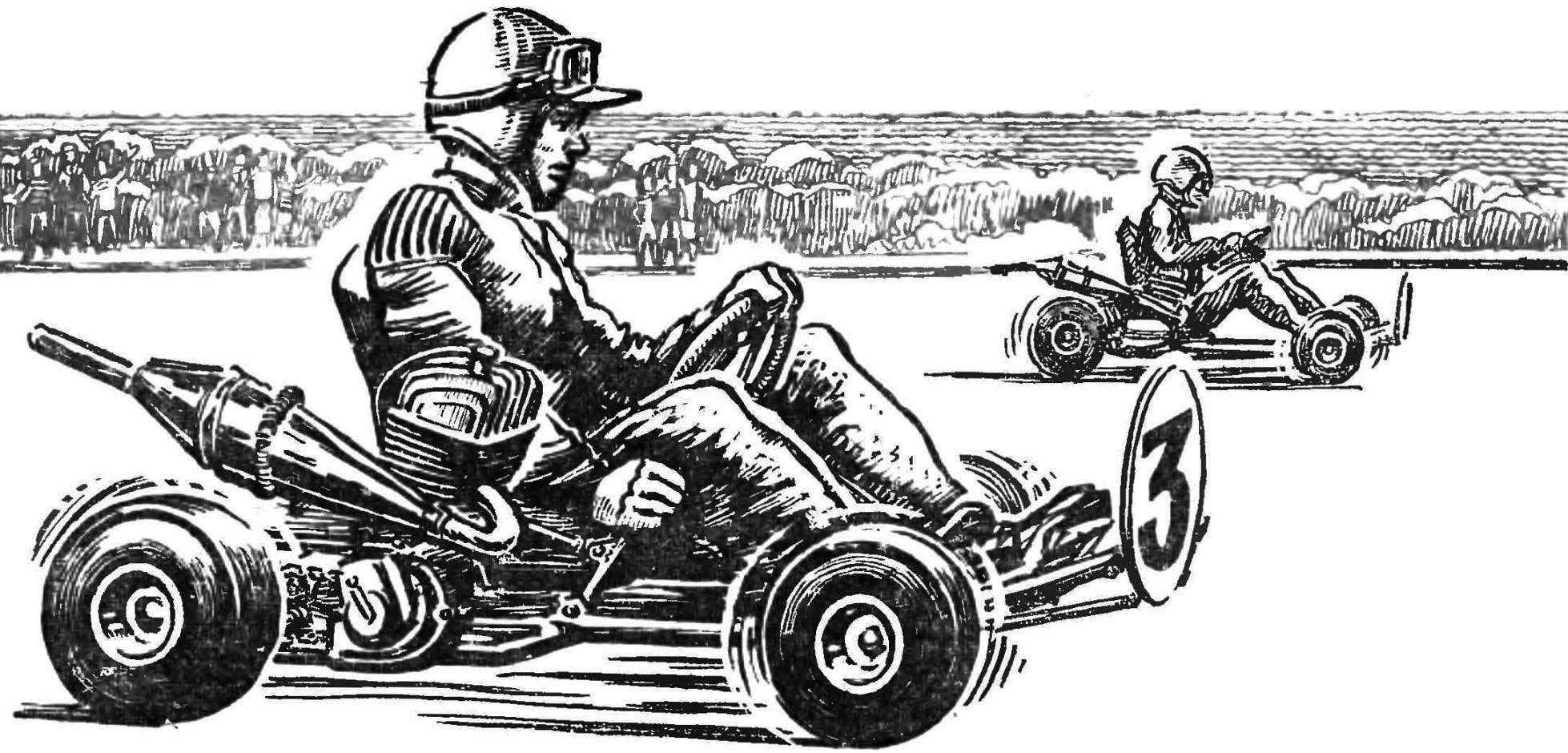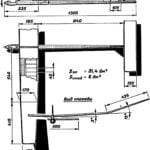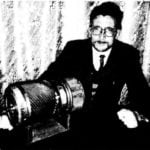 What started karting? In the 30-ies very popular among American boys was competition for non-motorised trolleys moving along slant paths. Some Joker aptly called them “racing soap boxes.” And not without reason. The first truck actually had instead of the body wooden box, attached the wheels, instead steering was a rope connected to the ends of the front axle. Over time, the “racing soap boxes” has gained the rank of all-American Championships, which often have become well designed and carefully made by non-motorised carriages. But their name lived for a long time.
What started karting? In the 30-ies very popular among American boys was competition for non-motorised trolleys moving along slant paths. Some Joker aptly called them “racing soap boxes.” And not without reason. The first truck actually had instead of the body wooden box, attached the wheels, instead steering was a rope connected to the ends of the front axle. Over time, the “racing soap boxes” has gained the rank of all-American Championships, which often have become well designed and carefully made by non-motorised carriages. But their name lived for a long time.
In 1951 the boys from the city of Phoenix had the idea to equip their “soap boxes” gasoline motor of the lawn mower capacity 3/4 horsepower. From that moment was born the first club of the small car: “micromicets”. Gradually the bearing body motorized “soap boxes” that limit access to the engine I transmission mechanisms were replaced by a melancholy frame, welded from pipe or angle iron. The club members developed the first technical requirements for which the length of machine 01раничнвалась 1.5 m, wheel diameter — 30 cm, and the weight after filling shall not exceed 92 kg. On the machines it was mandatory to have a protective arc behind the seats of the drivers, and every driver wore a seat belt a seat belt.
The adults followed the boys only five years later. In 1956, a professional racer Duffy Livingstone publicly demonstrated on the racetrack in Pomona maps built by mechanic Art Ingelson. Apparently, the novelty is liked by many. Not only in America but also in many European countries in a short time arose hundreds of go-kart clubs. Many firms started to manufacture karts and special engines for them, and the Newspapers at the time compared the distribution of go-karting with the flu epidemic.
In the Soviet Union the first message in the press about karting appeared at the end of 1960 and in January 1961 during the break between races, riders on the ice at Moscow stadium named after V. I. Lenin, the audience saw two unusual little car. One of them under the baton of Yuri Melikhov drove almost a whole lap. The “successes” of the second was even more modest. It is possible that they were the first domestic card. It is possible that at the same time in other cities were born of their future rivals. Anyway, in may 1961 at the first competitions in the city of Ventspils started 14 machii.
For a short history of karting and we have overseas designers and athletes are constantly looking for the best options for frames, the optimum size of the wheels, the most effective system brakes, not to mention the constant improvement of engines. For example, the frame of the kart was done surround (Fig. 1) or, on the contrary, is flat, made of steel thin-walled pipe, and even sheet profile, with a closed or open axle rear axle.
And objective judge of all the design successes and failures was the race. The best was machine, which in a small bumps on the racing tracks and turns always kept contact with the track all four wheels. The desire to achieve adaptability to the surface of the track, requires a certain elasticity of the frames, has led to the emergence on the maps of flat frames with a narrow front, open rear axle and the specific design of the front of the bridge card. On the machines with these frames won almost all the victories in the world cups and Europe. So most modern karts have such frame, which differ only in size, form rumble strips Yes, mounting hardware wheels and motors.
For a long time he conducted the search of the optimum sizes of wheels. In the early days of karting athletes used airplane “quilted” and wheels from scooters. But they did not satisfy the main requirements: to be as light as possible and yet have sufficient contact with the road. Practice has confirmed the inadvisability of increasing the diameter of the tire outside 310 mm, and tires of this diameter are available now especially for karts from us and abroad. But the width of the wheels is constantly growing. Tires type “Slicks”, which, in particular, serves national team of the USSR have the width of the treadmill about 20 cm, that is two times greater than that of tires, which comes with most karts.

Fig. 1
Equally important was the reduction in the total weight of the machines. First, not speed “micromicets” with light motors had a mass of about 60 kg In the first winter championship of the USSR in the race on the ice in 1966 more than half of the cars were heavier than 100 kg. the Use of alloy steels, aluminum alloys, and fiberglass allowed to build maps with a weight of 50-65 kg (depending on class). Weight reduction is sometimes achieved and design ways. For example, in the map “Super Boomerang” of steel tubes is made of only the carrier portion of the frame. It comes with a fiberglass design, combining the floor, the anatomical seat pad for a motor and the attachment point of the steering column (Fig. 2). The mass map without the engine was only 34 kg.
Many changes undergone and brakes. For example motorcycle designs on the cards initially set Shoe brake drive flexible cables. However, with increasing speed, the efficiency of these brakes were insufficient. In addition, a mechanical actuator required constant adjustment of uniformity of the braking force on the wheels, and after driving through puddles soaked pads often stopped to slow down. And then there was the “all weather” lightweight disc brakes, and later hydraulic drive, providing uniform braking of all wheels and require less effort on the brake pedal. Moreover, to enhance reliability of the brake system began to make a dual-circuit, separately for front and rear wheels.

Fig. 2
A large variety of designs different engines of the karts. However, there was determined the General direction. Here are some of them: the ratio of piston stroke to diameter of cylinder in almost all motors does not exceed one; on the cylinders is greatly enhanced fin; instead of a chain transmission motor — gear.
Carburetors with a Central float chamber was less sensitive to changes in fuel level when cornering. More reliable showed himself a contactless electronic ignition. In the first international class karts (without gearbox) are most commonly used engines with spool distribution. In other classes appeared engines with 5-6 speed transmissions. Widespread among Soviet athletes in the class of “Union” got the engine M-106 Minsk motorcycle, in the II international class engines “Chezet” model 934 Czechoslovakia. But which side is easier to install the engine, the consensus is still no. The engine map does not have forced cooling.
Therefore, it is necessary to set so that it was cooled counter flow of air. The left engine layout provides greater pedal stroke of the kickstarter and the ease of use it gives you the opportunity to place driven chain sprocket between the two bearings of the support and thereby eliminate the effect of harmful bending moment to the console of the rear axle. However, difficult access to the right side, where the elements of the ignition systems, require maintenance and frequent adjustment. In addition, the engines spool right distribution installed the carb with Vozduhoflotsky.
So athletes depending on engine design and General layout of the map nodes are used in both the location of the engine (Fig. 3).
The main features of the design of modern map are: flat tubular frame with a narrow front part, open rear axle; deep seat made of fiberglass, attached to the body of the athlete back and sides (the position of the seat frame is adjustable); wide-tire type “Clicks”; squeaks magnesium wheels for quick replacement of the tire in an inflated condition; wheel hubs aluminum alloy; disc brake with hydraulic transmission; plastic fuel tank, located under the steering column (fuel supply to the carburetor is carried out using the fuel pump).

Fig. 3
Karting, like all motorsports, is characterized by its own records. In the middle of the 130 years of Italian Livio Bans going to set a land speed record for karts with a piston engine. He used a slide valve engine, “Parilla” with a working volume of 100 cm3 and a normal map, but placed the reclining driver and installed the Light cone. On the Monza circuit at a distance of 1 km from the turn Bolis has a top speed 214,2 km/h.
With a light hand Bolisa some companies producing cards, in an effort to improve the appearance of their machines, began to put on them thin fairings-bodywork made of fiberglass. Elegant “shell” with a weight of only 3-3. 5 kg were fastened to the frame by three locks. If necessary, it can be easy to remove in just a few seconds. However, wide use sports cards fairings and has not received. The fact that the speed of karts on circuit races is relatively small, the resistance of the oncoming air flow slightly and fairings noticeable gain in speed does not give. Therefore, the national automobile Federation of several countries in the interest of maintaining maximum simplicity of construction of the sports karts forbidden to put them on any fairings or bodywork. But on maps intended for child transport villages security and for paid attractions (there are some!), the body is simply necessary. It protects the driver from dirt and dust raised from the track wheels, and eliminates the possibility of contact on the go with the front wheels and the transmission. If such a map is to limit the maximum speed, say, thirty miles per hour, it will be safe and very inexperienced “riders”, which is the majority among the visitors attractions. In addition, on the back of the card, it became possible to place rear view mirrors, blinkers, headlight, in the off position, closed the cover, and the rubber bump stop located around the perimeter of the machine. Maps now became like a “real” car, keeping its main features (small size, no suspension and differential, the steering is direct action, simplicity and cheapness of construction, etc.).
But back to the records. As soon as the international motor sport Federation allowed the use of cars jet drive, immediately there was a jet card. The relatively small mass of the card has given hope to designers it is easy to obtain the best ratio of thrust of the engine to the total weight of the crew and therefore good acceleration characteristics.
Once on the road in a small Austrian village of going the people saw extraordinary cards. Sam-cards was traditional, but with both sides secured two long tubes, and between them, behind the seat of the rider, was the parachute-brake. Designer and tester of a miracle machine, Georg Platzer in a home workshop built two simple pulse jet engine, tried them, having fixed on a workbench, and was now preparing to test “on the fly”.
Pletzer not invited timekeepers, and the length of the segment of the highway did not allow him fully to identify opportunities for their offspring.
More successful was the attempt of the Dane Engstrom. On the map, with two “signature” jet engines it reached speeds of 200 km/h. His result was soon improved American Mac Clairol. Card dragster Klajra specially designed for competition on acceleration, and had two jet engines with a total thrust of 245 kg, runs on liquid fuel and liquid oxygen. The total mass map with driver and fuel amounted to 154 kg. With such characteristics cards could vertically up in the air like a rocket. Well, on the horizontal track when you start at the end of the 400-meter distance Clair on your card reached a speed of 245 km/h.
Recently, the family of reactive replenished kart Kai Michelson (Fig. 4). On a single liquid-propellant engine Michelson is going for 6 cards to disperse to the speed of 360 km/h.

Fig. 4
In addition to piston and jet, in recent years, the idea of electric motors, the almost silent and not polluting the air. On these maps, it became possible to compete in closed spaces (for details, see “M-K” No. 10 of 1977). There are even cards with a steam engine without a firebox… and fuel! For a long time, the engineers were looking for a safe vehicle for warehouses and factories combustible and explosive substances. It is easy to imagine what can cause an inadvertent spark, for example, at a gunpowder factory. Here do not give a full guarantee, and special the electric vehicles. Besides the long, narrow passages in such places impose strict requirements to the size of the crew. The most passable were here “steam” cards. In his “pot” pour the liquid nitrogen, which rapidly boils at any temperature above minus 196° C. this creates a vapour pressure of nitrogen is required to actuate the steam engine. Using the card eliminates the need for a small, economical steam engine, not too polluting. And the one charging the “pot” enough for hours of continuous operation.
Today it is difficult to foresee what will be the card in a few years. Changes in their design and are associated with the overall development of automotive technology, and with the introduction of new forms of competition, and the emergence of other applications. So, the decision on carrying out in the USSR since 1978 racing on Packed snow (no studs) immediately reflected on the design “snow” machines. They were above normal (not to touch the frame when driving on the track). On some crews the rear dual wheels of steel. So we can confidently say that the growing popularity of karting and the improvement of the little race cars are keeping pace with the times.



